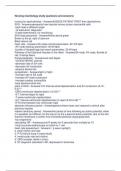Nursing (Cardiology study questions and answers)
nursing for dysrhythmias - AnswersASSESS PATIENT FIRST then dysrhythmia
EKG - Answersrepresents how impulse moves across myocardial cells
-each lead is different angle
-12 lead=brief, diagnostic
-5 lead=telementary, for monitoring
EKG lead placement - AnswersWhite above green
Brown to the pt. right of sternum
Black above red
heart rate - Answers-SA node=normal pacemaker, 60-100 bpm
-AV node=backup pacemaker, 40-60 bpm
-bundle of his/perkinge=last resort pacemaker, 20-40 bpm
Pathway of the Electrical Impulse in the Heart - AnswersSA node, AV node, Bundle of
His, Purkinje fibers
Parasympathetic - Answersrest and digest
-VAGUS NERVE controls
-decrease rate of SA note
-decrease AV conduction
-atropine blocks this
sympathetic - Answersfight or flight
-increase rate of SA node
-increase AV node conduction
-increase cardiac contractility
-beta blockers block this
parts of EKG - Answers-P-R interval=atrial depolarization and AV conduction (0.12-
0.2)***
-QRS=ventricular depolarization (<0.03)***
-S-T interval=depol to repol
-T wave=ventricular repolarization
-Q-T interval=ventricular depolarization to repol (0.34-0.43)***
-R-R=time between two ventricular repol
absolute refractory period - Answersperiod where heart cant respond to stimuli after
previous impulse
relative refractory period - Answersthe period of time following an action potential, when
it is possible, but difficult, for the neuron to fire a second action potential, due to the fact
that the membrane is further from threshold potential (hyperpolarized)
-too responsive
calculating HR - Answerscount R peaks for 6 seconds than multiply by 10
-most accurate=stethoscope on heart for 1 min
heart rate assessment - Answers1. p wave (upright)
2. atrial rhythm and rate
3. P-R interval (long in heart block)
4. ventirucular rate and rhythm
5. QRS complex (wide in d-tac)
6. ST stegment (elevated in MI, depressed in ischemia)
, 7. QR interval
8. T wave
3 sinus rhythm - Answers1. normal sinus: 60-100
2. sinus bradycardia: <60
3. sinus tachycardia: 101-180
-originates in sinus node
-upright p wave and QRS interval and constant rate
sinus bradycardia - Answers<60 bpm
-ASSESS PATIENT
-sx...dizzy, low BP, pale, cool, weak, syncope, chest pain, SOB, normal in athletes,
response to parasympathetic
-drugs that induce...beta blocker, digoxin, calcium channel blocker
-tx...ATROPINE if symptomatic, pacemaker
sinus tachycardia - Answers>100 bpm
-cause...exercise, pain, stress, fever, caffeine, shock, MI, anemia, albuterol, sudafed
-tx...tx cause!!!
premature atrial contraction (PAC) - Answersirregular sinus heart rhythm, extra normal
beats
-contraction from ectopic focus in atrium instead of SA node
-cause...CAFFEINE, hyperthyroidism, COPD, alcohol
-not concerning
paroxysmal supra ventricular tachycardia (PSVT) - Answers-reentrant rhythm
-cause...PAC triggers run of premature beats
-paroxysmal=abrupt onset and termination!!!
-tx...IV ADENOSINE, vagal maneuver, IV antecubital, DC cardioversion
atrial flutter - Answers-sawtooth waves from atrium
-AV node blocks some impulses
-associated w disease
-sx when atrial "kick" is lost and decreased CO leads to HF
-increased stroke risk
-tx...cardizem, antidysrhythmia, cardioversion, ablation
-goal...slow ventricular response
atrial fibrillation - Answerstotal disorganization of atrial electrical activity bc ectopic firing
-atrial rate 300-600
-NON IDENTIFIABLE P WAVE
-QRS narrow
-irregular rhythm
-causes STROKES
-risk...age, heart disease, 2ND POST OP DAY
-types...paroxysmal (sneaky and dangerous), persistent (dangerous), RVR (BAD HR
>100)
-tx...cardizem, cardioversion, ablation, anticoagulant
junctional dysrhythmias - Answers-originate in the AV node
-abnormal P wave
-normal QRS
-HR 40-60




